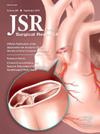Validating the Epic Deterioration Index (DI) for First Episode Rapid Response Team Activation in Sepsis Patients
IF 1.8
3区 医学
Q2 SURGERY
引用次数: 0
Abstract
Introduction
The epic electronic medical records software's deterioration index (DI) is an artificial intelligence-driven algorithm, which quantifies the probability of patient deterioration. Our study aimed to assess the relationship between DI score and activation of a rapid response team (RRT) and to identify a cutoff score to screen for deterioration events.
Materials and methods
A retrospective case control study was performed on adult sepsis patients across a nonprofit regional health network composed of 15 hospitals between August 2021 and April 2022. Linear mixed regression modeling was used to evaluate the impact of RRT status on DI scores. We then quantified the performance of the DI score for predicting first-episode RRT events using a threshold of 40.
Results
A total of 138 patients were included in this study; sixty-five patients were in sepsis with RRT cohort, and 73 patients were in sepsis without RRT cohort. The average DI score was 50.8 (31,557 DI scores) for sepsis with RRT and 26.8 for sepsis without RRT (34,279 DI scores). Although the DI score changed significantly throughout hospitalization, linear mixed regression failed to distinguish between the two cohorts based on the RRT status (P = 0.33). Using DI > 40 as a screening tool was 100% specific and 73% sensitive for predicting RRT in sepsis patients.
Conclusions
Despite higher average DI scores in RRT patients, there was no difference in DI score changes over time based on the RRT status; however, the DI score has the potential to serve as an effective screening tool for predicting deterioration events in sepsis patients.
求助全文
约1分钟内获得全文
求助全文
来源期刊
CiteScore
3.90
自引率
4.50%
发文量
627
审稿时长
138 days
期刊介绍:
The Journal of Surgical Research: Clinical and Laboratory Investigation publishes original articles concerned with clinical and laboratory investigations relevant to surgical practice and teaching. The journal emphasizes reports of clinical investigations or fundamental research bearing directly on surgical management that will be of general interest to a broad range of surgeons and surgical researchers. The articles presented need not have been the products of surgeons or of surgical laboratories.
The Journal of Surgical Research also features review articles and special articles relating to educational, research, or social issues of interest to the academic surgical community.

 求助内容:
求助内容: 应助结果提醒方式:
应助结果提醒方式:


